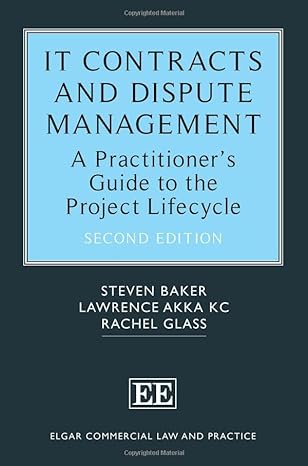There are many kinds of books on IT contracts out there. The ones that I came across early in my career contained checklists and sample clauses for a wide range of contracts. Mid-career, I found a 600+ page commentary on standard clauses in IT contracts, contracts for common services like cloud and consultancy, and particular issues such as escrow services and business continuity. These books certainly levelled me up, but I felt like something was missing. Being more a business partner to departments than assigned to churn out individual IT contracts, I wanted to learn more about legal considerations at each stage of the IT project lifecycle.
IT Contracts and Dispute Management: A Practitioner’s Guide to the Project Lifecycle is the book that fills this gap for me, a book I wish I had then.
Twenty-one chapters in the book provide guidance on each stage of a technology contract in the form of commentary, from pre-contract to contract negotiation and execution, performance (or non-performance), termination, enforcement, and dispute resolution. In addition it takes into account the latest judicial decisions in relation to technology projects, providing justification for its guidance.
Chapters One, Two and Three discuss the selection of contracting partners, pre-contractual documents such as tenders and letters of intent, project methodology, contract negotiation, as well as types of liability for false pre-contractual statements. Some people may think that it is taboo or negative at this stage to talk about court cases. However I found it helpful that the authors brought in relevant ones to expand on or illustrate certain points made.
Chapter Four touches lightly on the structure of tech contracts. Chapter Five, on breach of contract, estoppel, waiver, acquiescence, and variation. Interestingly it is titled “Housekeeping”, with the authors saying that good project housekeeping will help limit the scope for operational disputes, delays, and a breakdown in the parties’ relationship.
In some companies, project management is left completely to the project team to carry out. Nevertheless I suggest that lawyers still go through Chapter Six, which provides guidance on legal issues that may arise such as in relation to change control, and what kind of records ought to be kept.
Delivery and acceptance, testing, benchmarking, service credits, and delay are covered in Chapters Seven to Ten. Chapter Eleven contains a decent number of pages on project rescue which I savoured, as the other books on IT contracts that I read were light on project failure. The chapter talks about common approaches to resolving disputes mid-project, including de-scoping problematic areas, entering into ‘heads of terms’ or standstill agreements, step-in, and audit, and associated legal issues. My first project failure case was a monster and I could have used this chapter back then in generating options.
Chapters Twelve to Sixteen cover representations when re-baselining, termination rights, settlement considerations, interim dispute resolution, and enforcement of contract. Chapter Seventeen fearlessly tackles the issue of quantification of claims. The usual is covered: the rule against penalties, burden of proof, causation, remoteness. Then the chapter goes more in-depth into possible types of claims on a lost benefit basis, down to whether you can claim expenses incurred in preserving customers’ goodwill, say through an improved customer warranty.
It also goes more in-depth into claims on a wasted expenditure basis, monies paid to the supplier for example, and it suggests that claims for out-of-pocket expenditure and consultants’ fees which were incurred in reliance on the contract, and which were wasted due to the breach, can be recovered. Other topics covered are claims by the supplier, global claims, suing the tortious measure of damages, particular challenges with long-running disputes, and enforcement of indemnities.
Chapter Eighteen covers exemption and limitation clauses, and the last three chapters discuss dispute resolution forums, disclosure and document preservation, and factual and expert witnesses.
On the whole, this book is a solid reference suitable for newbies to the IT project lifecycle, as well as experienced lawyers given its consideration of recent court decisions. One thing to note is that the book is written from this lens. It does not examine the granular components of IT contracts, and so should be seen as a complement to other kinds of IT contract books not a one-stop shop.
Darren Grayson Chng is a data and tech lawyer in Singapore.
About the book

- IT Contracts and Dispute Management: A Practitioner’s Guide to the Project Lifecycle (2nd Edition) by Steven Baker, Lawrence Akka, Rachel Glass
- Published July 2023
- Hardback, 530 pages
- ISBN: 978 1 83910 795 5
- £190.00
Available as an ebook from £152.00 as well as from Amazon here.



